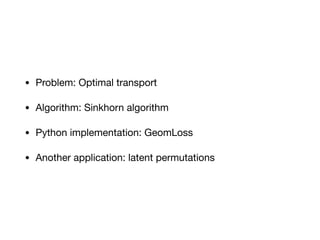20191019 sinkhorn
- 1. Sinkhorn algorithm and its applications PyData Osaka meetup #11 Taku Yoshioka
- 2. ? Problem: Optimal transport ? Algorithm: Sinkhorn algorithm ? Python implementation: GeomLoss ? Another application: latent permutations
- 4. ? Problem: Optimal transport ? Algorithm: Sinkhorn algorithm ? Python implementation: GeomLoss ? Another application: Jigsaw puzzle
- 5. Fitting generative models Observations Likelihood of generative model ? Fitting generative model using parameter gradient of likelihood of observations
- 6. Implicit generative model ? Likelihood not available ? Can generate samples Low-dimensional random variable Deterministic transformation (e.g., Neural network) High-dimensional random variable Typical example of implicit model
- 7. Fitting without likelihood function Observations Samples from generative model (likelihood not available) ? Fitting generative model without likelihood function (aka implicit models) ? Alternative to likelihood: distance between these sets of points (underlying distributions) ? To do this, GAN utilizes classi?er (JS-divergence)
- 8. Distance between distributions Observations Samples from generative model (likelihood not available) i j Cost matrix C = c11 ? c14 ? cij ? c41 ? c44 (e.g., Euclidean distance)
- 9. Transport cost 11 2 3 4 2 3 4 Transport cost 1 4 c13 + 1 4 c21 + 1 4 c32 + 1 4 c44 Cost matrix C = c11 ? c14 ? cij ? c41 ? c44 (e.g., Euclidean distance)
- 10. Transport cost 11 2 3 4 2 3 4 Transport cost 1 4 c11 + 1 4 c23 + 1 4 c34 + 1 4 c42 Minimum transport cost over possible assignment -> Optimal transport (discrete case) Cost matrix C = c11 ? c14 ? cij ? c41 ? c44 (e.g., Euclidean distance)
- 11. Generalization of assignment 11 2 3 4 2 3 4 Coupling matrix P = p11 ? p14 ? pij ? p41 ? p44 Transport cost ?C, P? °‘ °∆ ij CijPij Cost matrix C = c11 ? c14 ? cij ? c41 ? c44 p13c13 c42p42 °∆ j pij = 1 4 , °∆ i pij = 1 4 P1 = r, PT 1 = cGeneral form: p21c21
- 12. ? Problem: Optimal transport ? Algorithm: Sinkhorn algorithm ? Python implementation: GeomLoss ? Another application: Jigsaw puzzle
- 13. Regularized OT problem d = min P ?C, P?, d = min P ?C, P? ? ?H(P) Optimal transport Entropy regularized P1 = r, PT 1 = c
- 14. Regularized OT problem d = min P ?C, P?, d = min P ?C, P? ? ?H(P) Optimal transport Entropy regularized Solution obtained with Lagrangian (Cuturi 2013, Lemma 2) P = diag(u) ? K ? diag(v) Kij = exp(?cij/?), u °› 0, v °› 0 The same form of the solution obtained with Sinkhorn algorithm P1 = r, PT 1 = c
- 15. Sinkhorn algorithm u(k+1) = r Kv(k) v(k+1) = c KTu(k+1) pij = diag(u) ? K ? diag(v) Kij = exp(?cij/?), u °› 0, v °› 0 How to get u and v: repeat applying linear operations until convergence (stops at a ?nite iteration in practice) Sinkhorn and Knopp (1967) proposed this iterative algorithm and analyzed convergence.
- 16. Sinkhorn algorithm u(k+1) = r Kv(k) v(k+1) = c KTu(k+1) P = diag(u) ? K ? diag(v) Kij = exp(?cij/?), u °› 0, v °› 0 Backprop How to get u and v: repeat applying linear operations until convergence (stops at a ?nite iteration in practice) https://arxiv.org/abs/1706.00292
- 17. ? Problem: Optimal transport ? Algorithm: Sinkhorn algorithm ? Python implementation: GeomLoss ? Another application: Jigsaw puzzle
- 18. GeomLoss library (pytorch) https://github.com/jeanfeydy/geomloss ? Provides the following loss functions: ? Kernel norms (maximum mean discrepancies) ? Hausdor? divergences ? Unbiased Sinkhorn divergences ? Can be used in a wide variety of settings, from shape analysis (LDDMM, optimal transport°≠) to machine learning (kernel methods, GANs°≠) and image processing.
- 21. ? Problem: Optimal transport ? Algorithm: Sinkhorn algorithm ? Python implementation: GeomLoss ? Another application: Jigsaw puzzle
- 22. Latent permutations https://duvenaud.github.io/learn-discrete/slides/Gumbel-Sinkhorn-∫›∫›fl£s.pdf
- 23. Jigsaw puzzle
- 24. Jigsaw puzzle
- 26. Summary ? Optimal transport for measuring distance of distributions ? Sinkhorn algorithm is just a sequential application of linear operation, thus it°Øs possible to backprop ? GeomLoss makes it easy to use Sinkhorn algorithm with PyTorch ? Sinkhorn algorithm can be used to ?nd a good latent permutation from observation


























